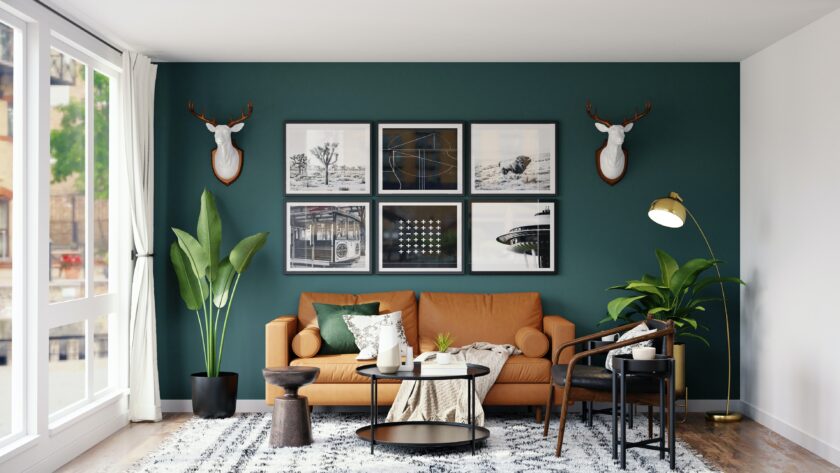Introduction
Feature walls have become increasingly popular in home decor, adding a touch of personality and style to any space. These visually striking elements can transform a room and create a focal point that grabs attention. By incorporating a feature wall, you can elevate the overall aesthetic appeal of your home and make a statement. In this blog post, we will explore the concept of feature walls and how they can enhance your living space.
What is a Feature Wall?
A feature wall is a single wall within a room that is intentionally highlighted or decorated differently from the other walls. It is a design element that stands out and draws attention. The purpose of a feature wall is to create visual interest and break up the monotony of a space. It serves as a focal point, directing the eye and adding depth and dimension to the room.
Feature walls can be created using various materials and techniques. Painted accent walls are probably the most popular choice, where one wall is painted in a bold or contrasting color to create a striking contrast with the surrounding walls. However, this doesn’t always need to be the case – wallpaper is another option, with a wide range of patterns, textures, and designs available to suit any style. Other possibilities include wood paneling, textured finishes, or even a gallery wall showcasing art or photographs.
The role of a feature wall in interior design goes beyond aesthetics. It can help define the purpose of a space, such as creating a cozy reading nook or highlighting a fireplace. It can also be used to draw attention to architectural details, such as an exposed brick wall or a decorative niche. Whether you want to make a bold statement or add subtle elegance, a feature wall can be a powerful tool in transforming your home’s ambiance.
In the upcoming sections, we will explore different types of feature walls, provide tips on choosing the right wall, and discuss creative ideas for implementing feature walls in various rooms of your home.
What Types of Feature Walls Can I Use?
Painted Accent Walls
One of the most common types of feature walls is a painted accent wall. By selecting a bold or contrasting color, you can instantly add drama and visual interest to a room. This option works well in any space, from living rooms to bedrooms and even bathrooms. Consider the color scheme of your existing decor and choose a shade that complements or stands out for a vibrant impact. Make sure you’re up to date with how to properly paint a wall.
Wallpaper Feature Walls
Wallpaper offers endless possibilities for creating a unique and eye-catching feature wall. Whether you prefer subtle textures, intricate patterns, or bold designs, there is a wallpaper style to suit every taste. From floral prints in a bedroom to geometric patterns in a home office, wallpaper can transform a plain wall into a captivating focal point. I’ll be doing a how to on wallpapering soon so watch this space!
Textured Feature Walls
Adding texture to a feature wall can bring depth and dimension to a room. Options include using materials like reclaimed wood, stone veneers, or decorative panels. These textured surfaces not only provide visual interest but also create a tactile experience. Consider incorporating natural elements for an organic and cozy feel or opt for sleek and modern textures for a contemporary touch.
Gallery Walls
A gallery wall is a creative way to showcase art, photographs, or other decorative items. It allows you to personalize your feature wall by curating a collection of meaningful pieces. Arrange frames in different sizes and shapes, mix and match artwork styles, or incorporate personal photographs to tell your story. Don’t have enough picture frames? Why not make your own? A gallery wall adds character and a personal touch to any space, whether it’s in the living room, hallway, or even the kitchen. The great thing about a gallery wall is that it can also be used in rented accommodation where you can’t make too many changes. Simply grab your favourite pictures and frames and put them up to create a cheap feature wall with all your treasured memories!

Architectural Feature Walls
Ever heard the phrase ‘shake what your mama gave ya?’ A great way to keep costs down is by emphasizing architectural elements that you already have in your home. Exposed brick, stone, or concrete walls can be left bare or enhanced with lighting to highlight their natural beauty, such as the lightly painted bricks shown below. Alternatively, decorative moldings, wall niches, or built-in shelving can be incorporated to add architectural interest and make a statement in the room.
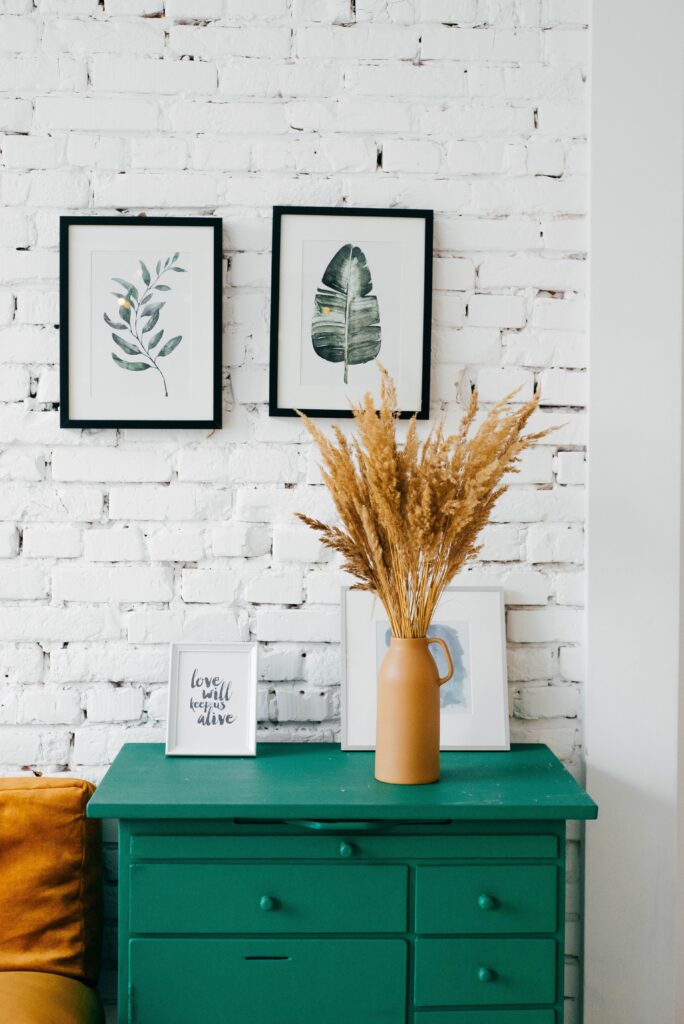
As you consider the different types of feature walls, think about the overall style and atmosphere you want to achieve. Take into account the existing decor and the purpose of the room. Each type of feature wall offers unique possibilities, allowing you to unleash your creativity and transform your space into something extraordinary.
Where Can I Put Feature Walls?
When selecting the wall for your feature wall, it’s important to consider the specific needs and characteristics of the room. Different rooms have different purposes and design considerations. Here are some tips for choosing the right wall based on the type of room:
Living Room or Lounge
In the living room, you’ll want to choose a wall that naturally draws attention. Consider the wall that is directly facing the entryway or the wall behind the main seating area. This will create a focal point and add visual interest to the space.

Bedroom
In the bedroom, you can create a feature wall behind the bed to add a touch of drama and create a cozy ambiance. Consider using a textured wall, a wallpaper with a soothing pattern, or even a painted accent wall in a calming color.
Kitchen
In the kitchen, the feature wall can be a great opportunity to showcase your personal style. Consider choosing a wall behind open shelves, above the kitchen counter, or even the area around the stove. This can be an ideal spot to incorporate a tiled backsplash, a chalkboard wall, or a unique material like brick or reclaimed wood.

Bathroom
In the bathroom, a feature wall can elevate the overall design and create a spa-like atmosphere. Consider choosing a wall behind the vanity or the bathtub. You can opt for a statement wallpaper, a mosaic tile pattern, or a textured wall surface to add visual interest and depth to the space. In our bathroom we have the wall behind the shower tiled with the other 3 walls painted an off white colour.
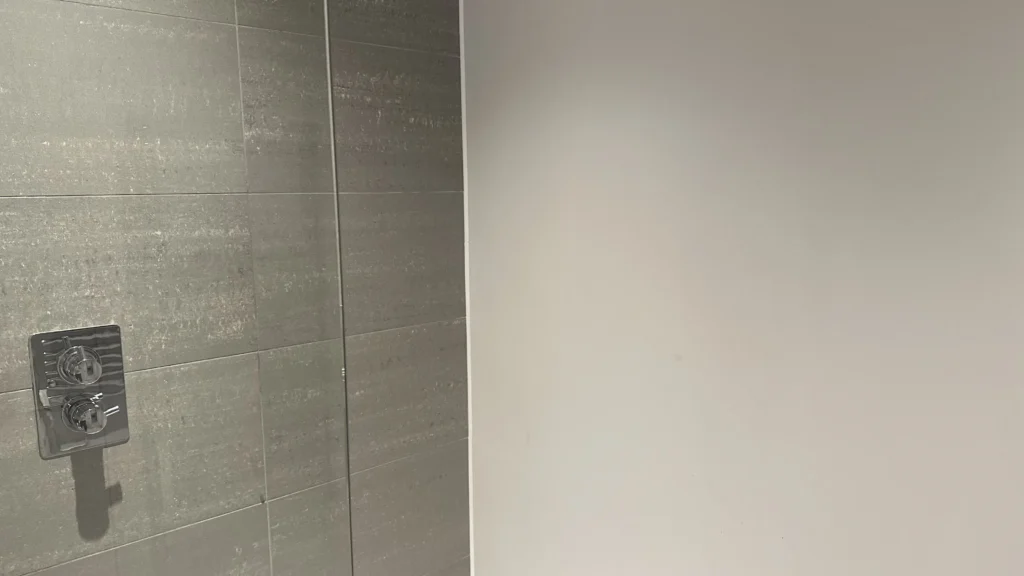
Home Office
In a home office, the feature wall can inspire creativity and enhance productivity. Choose a wall that is visible from your workspace or behind your desk. Consider using a bold paint color, a graphic wallpaper, or a gallery wall of motivational quotes and artwork.
When selecting the right wall for your feature wall, also consider the lighting in the room. Ensure that the wall receives sufficient natural or artificial light to highlight its design and make it a standout feature. Additionally, keep in mind the existing layout and furniture arrangement to ensure the feature wall complements the overall flow of the room.
By carefully choosing the right wall for your feature wall, you can create a harmonious and visually appealing space that reflects your personal style and enhances the atmosphere of the room.
How Should I Plan and Prepare a Feature Wall?
Before diving into creating your feature wall, proper planning and preparation are essential to ensure a successful outcome. Follow these steps to make the process smoother:
1. Define Your Vision
Start by clarifying your vision for the feature wall. Consider the style, theme, and color scheme you want to incorporate. Browse through interior design magazines, websites, and social media platforms for inspiration and ideas.
2. Choose the Right Material
Select the material that best aligns with your vision and the overall aesthetic of the room. This can include options such as paint, wallpaper, reclaimed wood, tiles, stone, or even fabric. Each material offers unique textures and finishes, so consider how they will enhance the space.
3. Measure and Prepare the Feature Wall
Accurate measurements are crucial for a seamless installation. Measure the dimensions of the chosen wall and consider any architectural elements like windows, doors, or outlets. Clear the wall of any existing decor, such as artwork or shelves, and ensure the surface is clean and smooth.
4. Experiment with Samples
If you’re unsure about the color or pattern, obtain samples or swatches of the chosen materials. Test them in the room’s lighting conditions and observe how they interact with the existing elements. This step allows you to make informed decisions before committing to the final design.
5. Create a Layout Plan
Use painter’s tape or a design software to create a layout plan on the wall. This step helps visualize the positioning of the feature elements, such as wallpaper panels, painted shapes, or shelves. Experiment with different arrangements until you find the most appealing composition.
6. Gather the Necessary Tools and Supplies
Depending on the chosen material and installation method, gather the appropriate tools and supplies. This may include paintbrushes, rollers, adhesive or paste, cutting tools, level, measuring tape, and protective gear like gloves and goggles. Having everything ready before starting will streamline the process.
7. Set a Realistic Timeline
Consider the complexity of the project and allocate sufficient time for each step, including drying or curing periods for certain materials. Setting a realistic timeline prevents rushing the process and ensures a high-quality result.
By carefully planning and preparing for your feature wall project, you can minimize errors, avoid unnecessary delays, and achieve the desired outcome. Taking the time to consider your vision, choose the right materials, and create a solid plan sets the stage for a successful and visually striking feature wall.
Installation and Execution
Once you have completed the planning and preparation phase, it’s time to move on to the installation and execution of your feature wall. Follow these steps to bring your vision to life:
- Gather Your Materials: Before starting the installation, ensure that you have all the necessary materials and tools at hand. This may include paint, wallpaper, adhesive, brushes, rollers, measuring tape, level, and any other supplies specific to your chosen design.
- Follow Proper Instructions: Whether you’re applying paint, wallpaper, or other materials, it’s crucial to follow the manufacturer’s instructions and recommended techniques. This will ensure optimal results and durability. Pay attention to details such as mixing ratios, drying times, and application methods.
- Start with a Solid Foundation: If you’re painting the feature wall, consider applying a primer coat to create a smooth and even surface. This helps the paint adhere properly and ensures better color saturation. For wallpaper or other materials, ensure that the wall is clean and free from dust or debris.
- Work in Sections: To maintain control and achieve a consistent result, divide the wall into manageable sections. This approach is particularly useful when working with large surfaces or complex patterns. Start from one corner and work your way across, ensuring seamless transitions between sections.
- Take Your Time: Installing a feature wall requires patience and attention to detail. Take your time to apply paint or wallpaper evenly, align patterns accurately, or affix other materials securely. Rushing through the process may lead to mistakes or a subpar outcome.
- Check for Level and Alignment: Throughout the installation, regularly use a level to ensure that your feature wall remains straight and aligned. This is particularly important when working with patterns or multiple panels. Adjust as needed to maintain a professional finish.
- Address Imperfections: If you encounter any imperfections or mistakes along the way, don’t panic. Depending on the material, you may be able to make corrections or touch-ups. For example, if you notice a paint drip or a misaligned wallpaper section, carefully remove or correct it before it dries or sets.
- Allow for Proper Drying or Curing Time: After completing the installation, it’s crucial to allow the materials to dry or cure fully before moving furniture back or adding decor. Follow the recommended drying times provided by the manufacturer to avoid smudges, smears, or damage to the finished wall.
By following these installation and execution tips, you can achieve a beautifully executed feature wall that enhances the aesthetics of your space. Take your time, work methodically, and pay attention to the details to create a visually captivating focal point in your home.
Showcasing and Styling Your Feature Walls
Once your feature wall is installed, it’s time to showcase and style it to maximize its impact in your space. Consider the following tips to highlight and enhance the visual appeal of your feature wall:
- Lighting: Proper lighting can significantly enhance the look of your feature wall. Use strategically placed lighting fixtures, such as wall sconces or spotlights, to create a dramatic effect and draw attention to the wall. Experiment with different lighting angles and intensities to achieve the desired ambiance. Make sure you know how to change a light bulb first though!
- Complementary Decor: Choose decor and furnishings that complement your feature wall and enhance its overall aesthetic. Consider the color scheme, patterns, and textures of the wall when selecting furniture, artwork, curtains, and other decorative elements. Aim for a cohesive and harmonious look that ties everything together.
- Minimalist Approach: Sometimes, less is more when it comes to showcasing a feature wall. Avoid cluttering the area with too many accessories or decor items that may distract from the wall itself. Instead, opt for a minimalist approach, allowing the wall to take center stage and serve as the focal point of the room.
- Artwork and Wall Decor: Use your feature wall as a backdrop to display artwork, photographs, or other wall decor. This can create a layered and visually interesting effect. Consider the scale, color, and theme of the artwork to ensure it complements the wall and adds to the overall ambiance.
- Balance and Symmetry: Achieve a sense of balance and symmetry by placing furniture or decor items in a way that complements the feature wall. Arrange furniture in a way that frames the wall or creates a visual connection with it. Use symmetry in the placement of accessories or decor to create a harmonious look.
- Texture and Contrast: Add visual interest to your feature wall by incorporating elements of texture and contrast. Consider using textured wallpaper, a textured paint finish, or adding decorative elements such as wood paneling, reclaimed materials, or geometric patterns. These additions can create depth and dimension, making the wall even more captivating.
- Seasonal Refresh: Don’t be afraid to switch up the decor on your feature wall to reflect different seasons or occasions. Add seasonal accents, such as wreaths, garlands, or themed artwork, to keep the wall fresh and engaging throughout the year.
- Regular Maintenance: Keep your feature wall looking its best by regularly cleaning and maintaining it. Dust the surface, spot-clean any marks or smudges, and address any signs of wear or damage promptly. This will help preserve the wall’s aesthetic appeal and ensure its longevity.
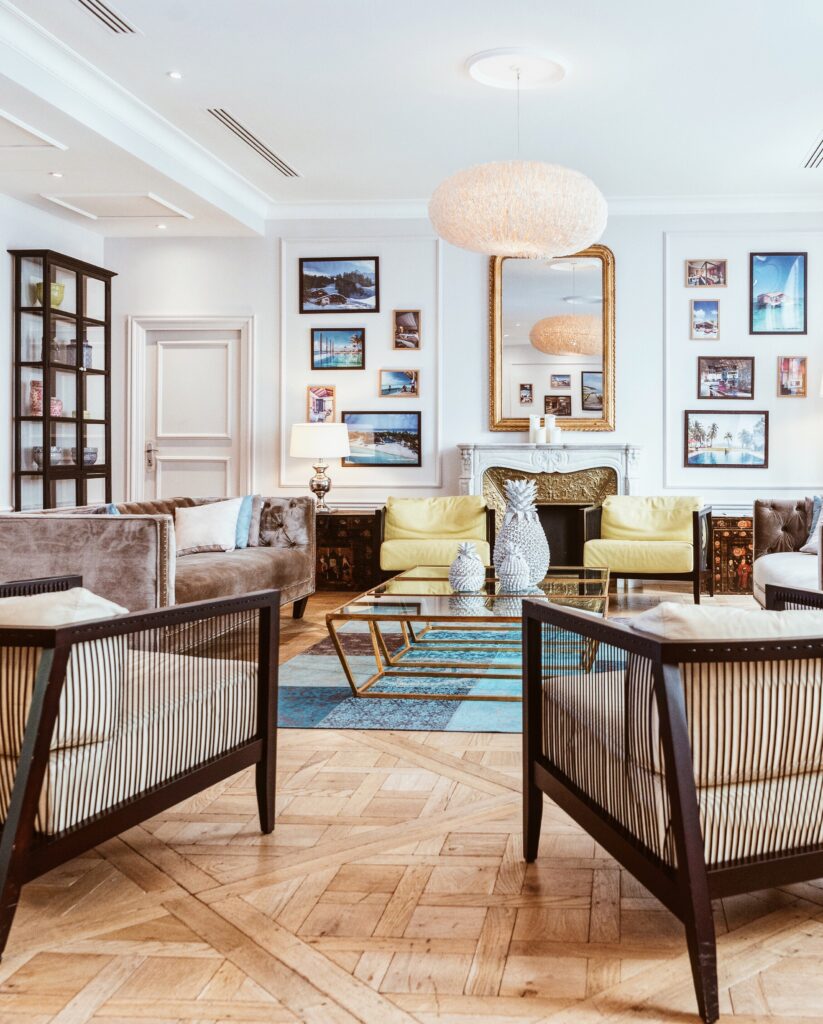
Consider the interplay of lighting, decor, and complementary elements to bring out the full potential of your feature wall and make it a focal point that truly elevates your home’s design.
Maintaining and Caring for Your Feature Walls
To keep your feature wall looking its best and maintain its longevity, it’s important to implement proper maintenance and care practices. Follow these guidelines to ensure your feature wall remains in top condition:
- Regular Cleaning: Dust the surface of the wall regularly to prevent a buildup of dirt and debris. Use a soft cloth or a duster to gently wipe down the wall, taking care not to damage any delicate or textured surfaces.
- Spot Cleaning: Address any stains or marks on the wall promptly. Use a mild cleaning solution, such as a mixture of warm water and gentle dish soap, to spot-clean the affected area. Avoid using abrasive cleaners or harsh chemicals that can damage the surface.
- Protection from Moisture: If your feature wall is located in a bathroom, kitchen, or any area prone to moisture, take precautions to protect it. Apply a waterproof sealant or a moisture-resistant paint finish to safeguard the wall from water damage. Additionally, ensure proper ventilation in the room to minimize excess humidity.
- Touch-Ups and Repairs: Regularly inspect the feature wall for any signs of wear, chipping, or damage. Address any issues promptly by performing touch-ups or repairs. Keep the original paint or materials used for the wall handy to ensure a seamless and consistent finish.
- Avoid Direct Sunlight: If your feature wall is exposed to direct sunlight, be mindful of potential fading or discoloration. Consider using window treatments, such as curtains or blinds, to block excessive sunlight and protect the wall’s integrity.
- Furniture Placement: Take care when moving or rearranging furniture near the feature wall. Avoid scratching or damaging the surface by using protective pads or felt sliders on furniture legs. Be cautious when hanging or placing heavy objects on the wall to prevent any potential damage. Make sure to hang any shelves properly depending on what type of wall it is.
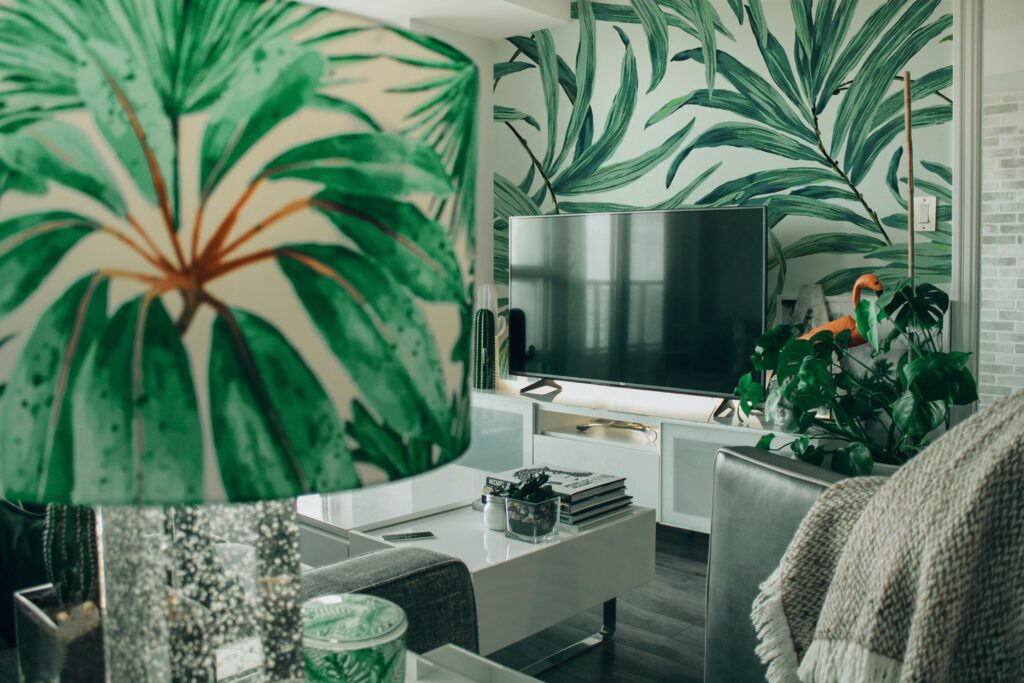
Benefits of Feature Walls
I personally LOVE a feature wall. It’s such a lovely way to show off your personality and it can really open up a previous drab room.
- Visual Impact: A well-designed feature wall instantly grabs attention and becomes a focal point in the room. It adds visual interest and can serve as a conversation starter, creating a dynamic and engaging space.
- Personal Expression: As I said, feature walls provide an opportunity to showcase your personal style and creativity. Whether it’s through unique paint colors, textured wallpapers, or decorative elements, feature walls allow you to express your individuality and create a space that reflects your taste.
- Depth and Dimension: By incorporating different materials, textures, or patterns, a feature wall adds depth and dimension to a room. It can visually expand the space or create a sense of coziness, depending on the design and color scheme chosen.
- Room Definition: A feature wall can help define different areas within an open plan living space. By strategically placing the wall, you can visually separate the living area from the dining area or designate a specific zone in a multipurpose room.
- Versatility: Feature walls can be adapted to suit various rooms and design styles. From bedrooms to living rooms, kitchens to home offices, feature walls can be customized to enhance the ambiance and functionality of any space.
- Concealing Flaws: If there are imperfections or architectural flaws in a wall, a feature wall can provide a practical solution. It can draw attention away from less desirable aspects of a room and redirect focus to the visually appealing feature.
- Flexibility and Easy Updates: Feature walls offer flexibility when it comes to design and updates. Whether you want to experiment with bold colors, change the decor, or refresh the wall with new patterns or textures, feature walls can be easily updated to suit your evolving preferences.
- Increased Property Value: Well-executed feature walls can enhance the overall value of your property. A visually striking feature wall can leave a lasting impression on potential buyers or renters. It adds a unique touch to the space and sets your home apart from others, increasing its appeal and market value.
- Acoustic Benefits: Depending on the materials used, a feature wall can provide acoustic benefits by reducing noise transmission. For example, textured wall panels or acoustic wallpapers can absorb sound and improve the acoustics of a room.
- Temporary and Cost-Effective: Feature walls offer a cost-effective way to update and transform a space without undergoing a complete renovation. They provide an opportunity to experiment with different styles and designs, and if desired, they can be easily changed or removed without significant expense or effort.
Remember, when planning and executing a feature wall, it’s essential to consider your personal style, the overall design concept of the room, and the specific purpose you want the wall to serve. With careful consideration and thoughtful execution, a feature wall can truly transform your living space.
In Conclusion
A well-designed and thoughtfully executed feature wall has the power to transform any room in your home. It adds character, depth, and visual interest, elevating the overall aesthetics and creating a focal point that draws attention. Whether you choose to incorporate bold colors, unique textures, or eye-catching patterns, a feature wall allows you to express your personal style and make a statement.
Throughout this article, we have explored the various aspects of feature walls, from selecting the right wall and materials to planning, execution, maintenance, and the numerous benefits they offer. Remember to consider your space, purpose, and desired atmosphere when designing a feature wall. Take the time to plan and prepare, ensuring proper installation and execution, and don’t forget to regularly maintain and care for your feature wall to keep it looking its best.
So, if you’re looking to add a touch of style, creativity, and personality to your home, consider incorporating a feature wall. With careful thought, planning, and execution, you can transform any room into a stunning and captivating space that reflects your unique taste and creates a lasting impression. Embrace the opportunity to make a statement with a feature wall and enjoy the transformative power it brings to your living environment.

